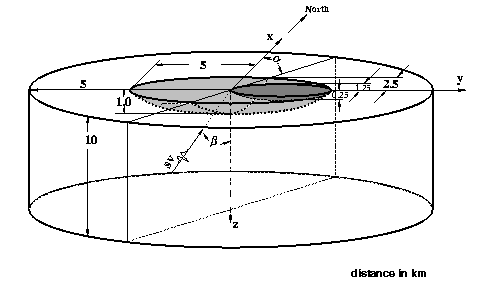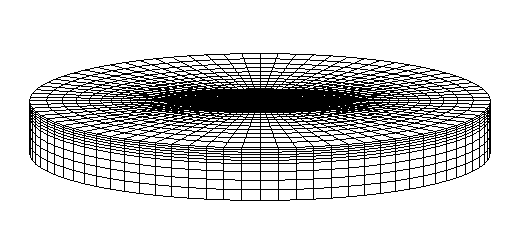 Animated 3D simulation
Animated 3D simulation
 Animated 3D simulation
Animated 3D simulation
This page describes an animated numerical simulation of the three-dimensional seismic response of a synthetic alluvial basin. The simulation was written by hand, using a regular block-structured mesh, and run on a CM-2. The difficulty of building an efficient simulation by hand, even with the simple block-structured mesh, motivated the development of Archimedes, a parallelizing compiler for irregular finite element problems.
 Figure 1: Input system
Figure 1: Input system
The material in each component is isotropic, homogeneous, and linearly elastic. The specific material properties of each component are given below:
The excitation is given by an incident SV-wave in the form of a Ricker wavelet with dominant period Tp = 4 s, which corresponds to the fundamental natural period of a flat layer on a rigid base with the same depth and shear wave velocity as the middle of the small basin. The total duration of the incident wave is 10.2 s, its amplitude is 1, and the angles of incidence are alpha = 90o and beta = 20o.
Shear wave Poisson's Density Component velocity (km/s) ratio (g/cm^3)
Small basin 0.25 0.25 1.8 Larger basin 1.00 0.25 2.3 Halfspace 2.50 0.30 2.6
 Figure 2: Block-structured mesh
Figure 2: Block-structured mesh
The excitation is defined in terms of effective forces acting at the interface between the outer basin and the halfspace. An absorbing boundary of viscous dampers is placed at the lateral and bottom surface of the computational domain to limit spurious reflections.
 MPEG animation (2 Mbytes)
MPEG animation (2 Mbytes)
The MPEG animation shows the history of the horizontal surface displacement in the EW longitudinal direction within the two basins and a portion of the halfspace. Amplitude of motion is indicated by height and color scale (the maximum response is 25). Time appears in the bottom right corner of each frame.
quake@cs.cmu.edu